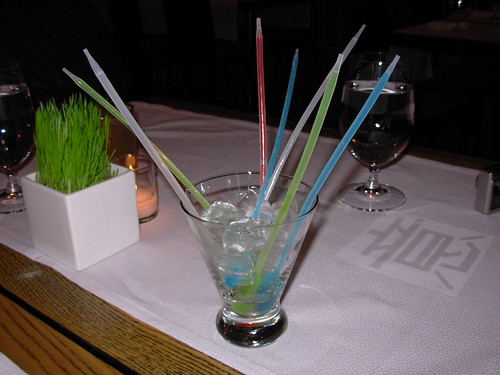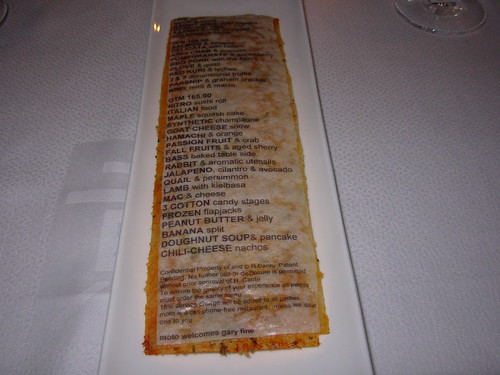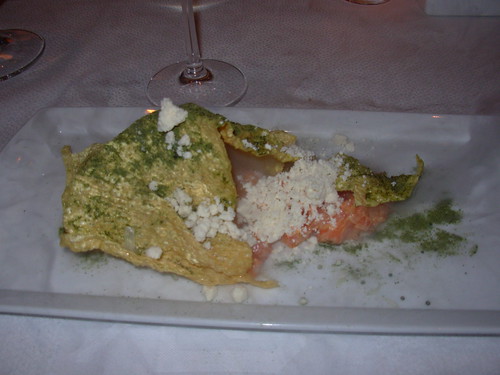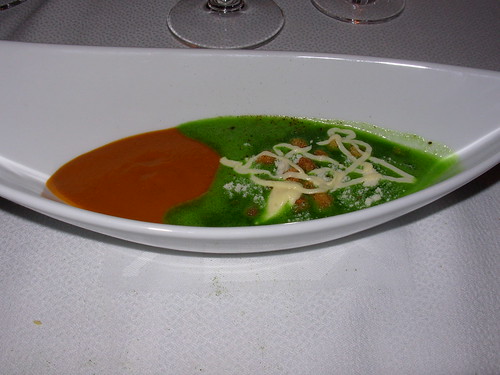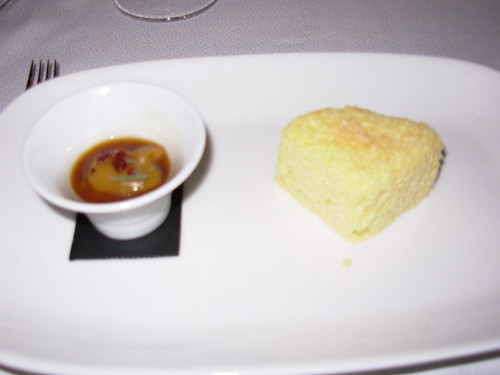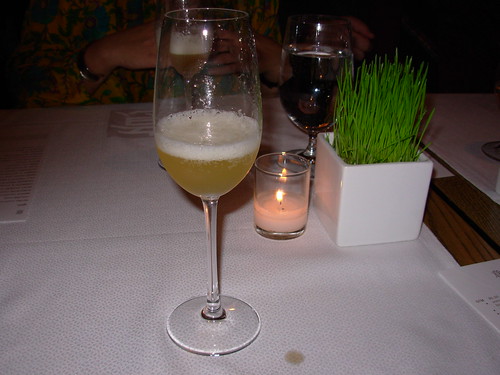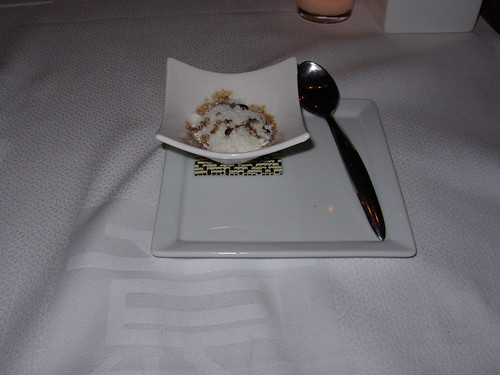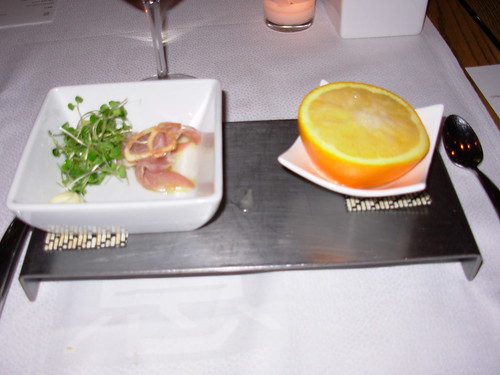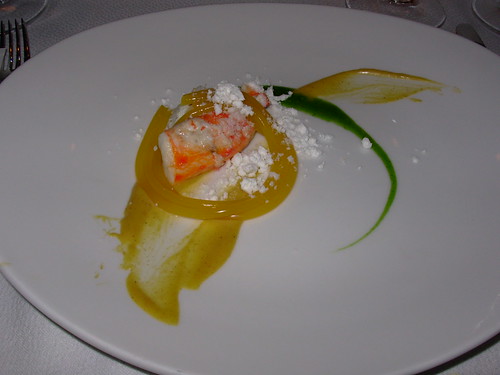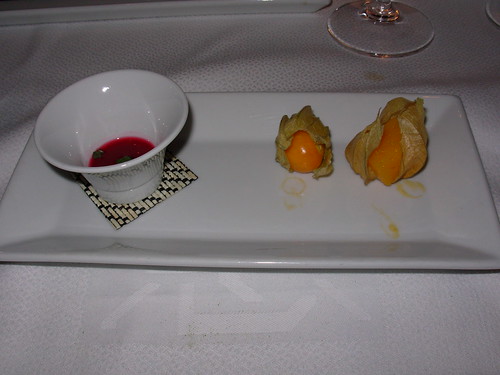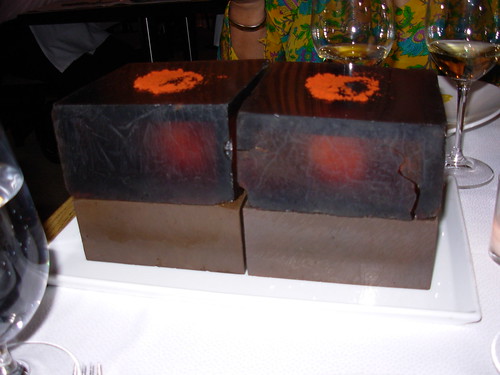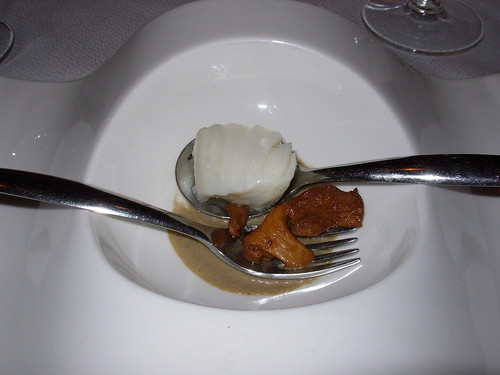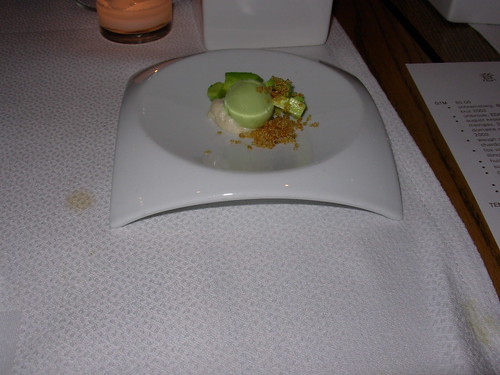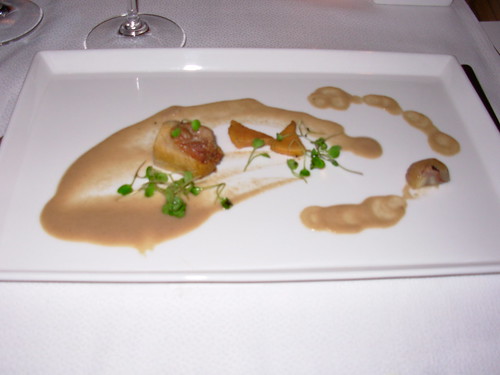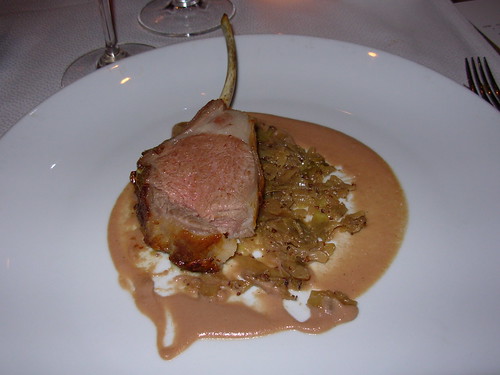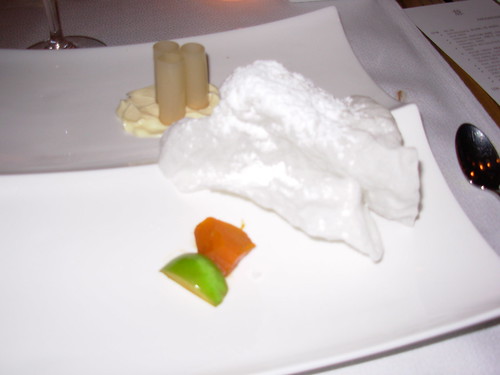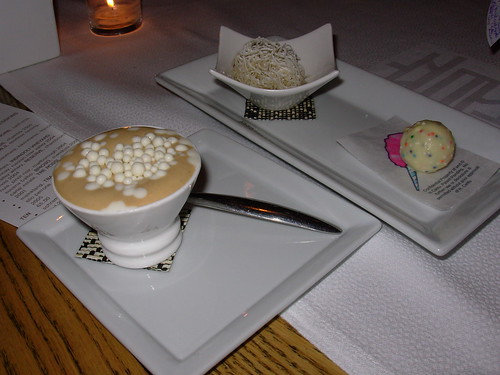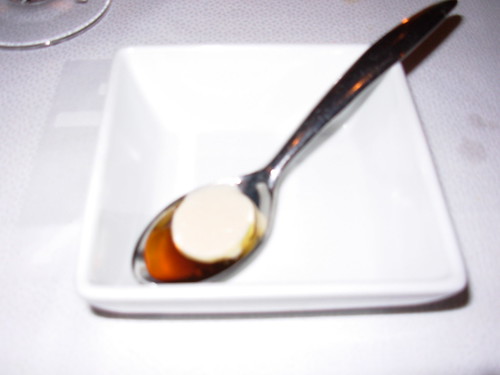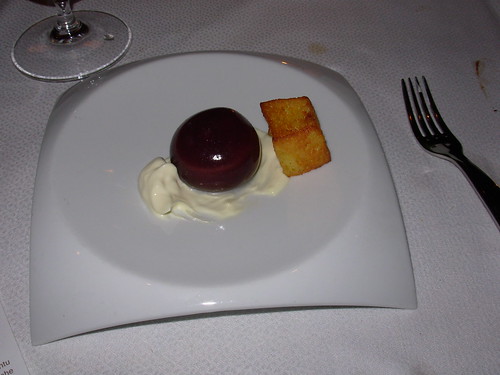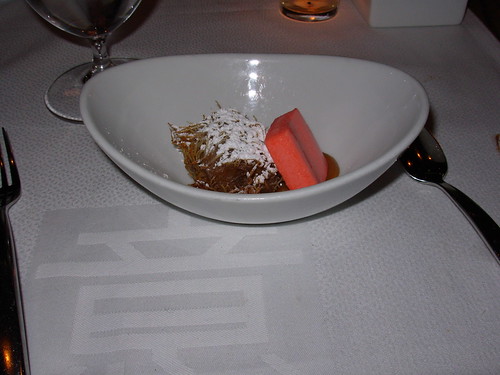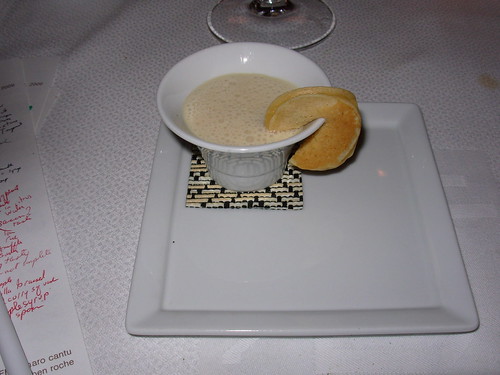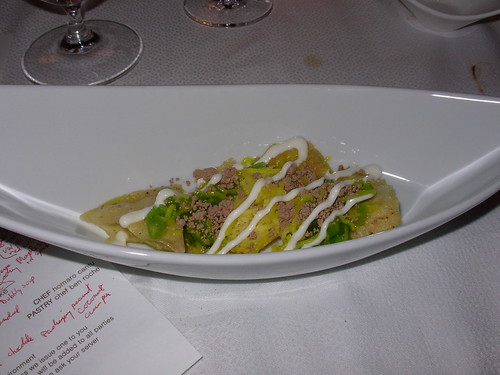10:01 Wednesday morning found me punching numbers into my cell phone, cadging a new reservation at Schwa, Chicago chef Michael Carlson's hot and intimate storefront amazement. Less than twelve hours earlier I had been finishing dessert under Carlson's command. I had been away last year when Schwa opened to squeals of delight and unaccented schwa-y sighs.
Carlson is a graduate of the Grant Achatz school of dining as aristocratic amazement and has worked with Hester Blumenthal at England's noble Fat Duck, but Schwa has a different vision. Cooks fantasize opening a small boîte for the pleasure of a small circle of friends. And some few do. Michael Carlson is one. Schwa is a 28-seat restaurant in what some high-toned folk have labeled a "dodgy" stretch of Western Avenue (an ungentrified area of Chicago's West Town). The restaurant is situated in a pleasant-enough storefront, although sniffers might deduct points for decoration as some did for the late lamented Matsumoto (and seated by the radiator, my hot flashes were not only from the passion of the kitchen). Music piped courtesy of local white rappers, the melodic preference of the staff. Schwa's soundtrack is many leagues from Le Cirque.
The staff consists of three cooks, a helper, and a server, although everyone, including Chef Carlson (and Sous Chef Nathan Klingbail), carried plates. With two set degustations (including the eleven course menu I selected), the staff had a firm idea of their evening tasks. With the price of the full menu at $100/person (comparable to Moto or Daniel Humm's Eleven Madison Park in New York), savings from their modest rent is not passed on. Schwa is not a restaurant that is unaware or ashamed of its skills. (Schwa doesn't have a wine list, and the corkage fee is a wildly, trippingly modest $5.00/table).
Carlson's cuisine owes much to Achatz and other culinary modernists, although Schwa not as showy as Alinea or as antic as WD-50. I was struck by Carlson's use of negative space. As with minimalism in art, the emptiness directs attention. If the food was molecular, some plates could have used a microscope (OK, a magnifying glass). The pictures tell the tale. When I arrived home after my eleven-course banquet, I prepared a snack.
Let my phone call serve as evidence of my esteem. Michael Carlson among the most compelling and original chefs cooking today, an artist to watch. The opening of Schwa is a significant culinary event, dividing the decorator from the cook. As one who has groused at the "Disappearing Chef Syndrome," it is comforting to see Chef Carlson laboring at his stove. This is a chef who unlike some Iron Chefs doesn't need a map to find his restaurant. Should you find a hair in the soup, test for Carlson's DNA. Had not Alinea opened in 2005, Schwa is a dream personally sauteed and souffled.
Still, the critic's code of ethics prevents me from claiming that my meal was the brightest of the year (I ate at Per Se three times; Schwa was an improvement over one of those meals). Some dishes were sublime, splendid, and spectacular, some soared, and a few were good. Throughout the meal, a diner realized that there are some luxe touches that only a capacious staff can provide. Schwa's perfection was in the combination of astonishing food in its tight sphere - the diner's faith in the craftsman's touch.
Chef Carlson saved the worst for first. The amuse was two small candied apple balls, sprinkled with fleur de sel. The salt was startling, but the apple was more Coney Island than Midtown. Modest, but not deceptively so. I began to muse about hype.
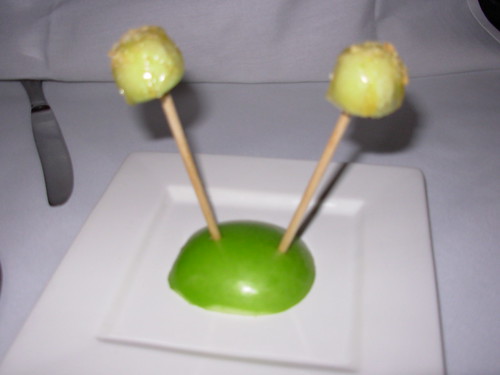
Happily the salad course set things right. Chef Carlson composed an engaging salad with white anchovy, apples, celery, celery root, and Manchego cheese. With its bold flavors, subtle colors, and unassuming ingredients, it could have been an homage to Charlie Trotter. It was a dish that owed more to the new American cuisine that Trotter has been linked to than to the revolutionary fervor of molecular dishes. The salad was a blissful, bright introduction to Schwa's range.
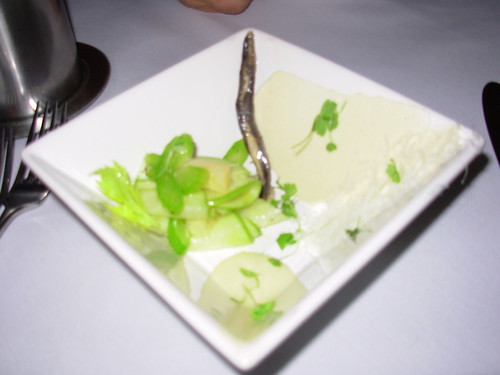
For soup, we were treated to a theatrical set-piece, Prosciutto Consomme with Melon and Arugula, a dish perhaps inspired by the vertical cuisine of Alfred Portole at Gotham Bar and Grill. Stacked languidly, as if 2x4s left by a casual carpenter, were two thin shaved slices of ham, one crispy and one smoked and thinly cut. The neighboring cup of bullion proffered the purest essence of ham. The fresh melon and arugula flakes were bit players in this moist and porcine drama.
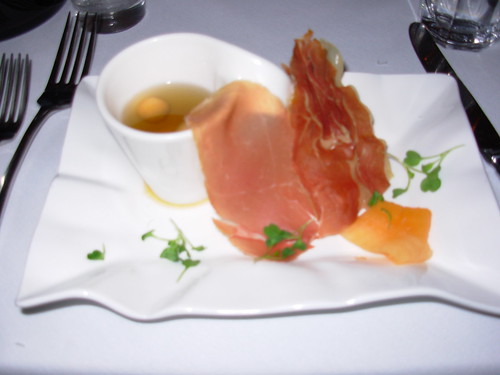
Carlson's Quail Egg Ravioli is that rare act of inspiration that could qualify a chef for a Genius Award. My companion asked if he could skip the rest of the menu and be served a heaping bowl. The ravioli was served with ricotta, brown butter, parmigiano reggianno, and as much white truffle as Caligula would need for a month of orgies. Here was a dish that channeled Thomas Keller, while knowing how much truffle to perfume the quail egg before a defibrillator was required. Be still my beating heart! Carlson has created the most erotic recipe this side of Tampopo, lush, gooey, musky, preposterous, and very, very opulent.
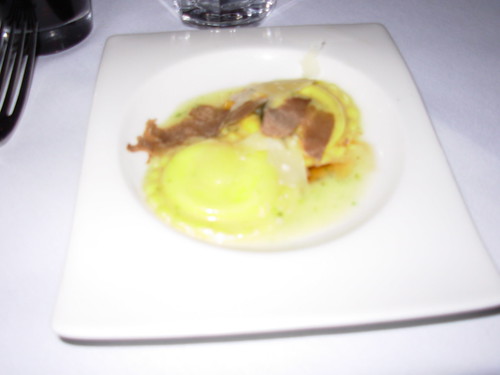
Looking at "Illinois Sturgeon Caviar with Avocado and Cauliflower," one might imagine another Keller inspiration. It wasn't quite. Serving Illinois Sturgeon Caviar might satirize our desire to eat local at all cost. This was roe that serves in a pinch. The creamy cauliflower was a more joyous match than the avocado.
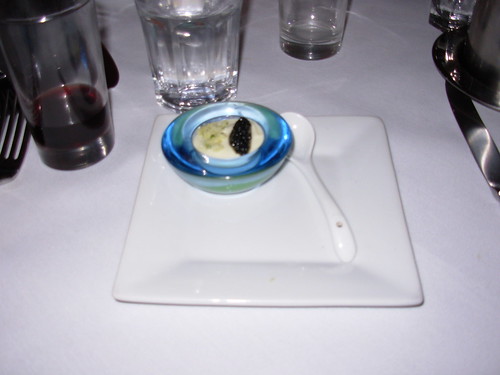
The butter-poached lobster was a surprise, off-the-menu entry, and it was the first of Carlson's minimalist, molecular dishes. The lobster was served with sauteed gooseberries, potatoes, and Swiss chard napped with a lavender emulsion foam. The lavender brightened the shellfish with its flowery floral overtones. In the past year, I have had some remarkable lobster dishes, and this lobster can be inducted into the club. By placing pieces of the lobster on the rim of the plate, Chef Carlson engaged in frame-breaking, emphasizing how much of the plate was unused and how airy his presentation. This was another glittering combine.
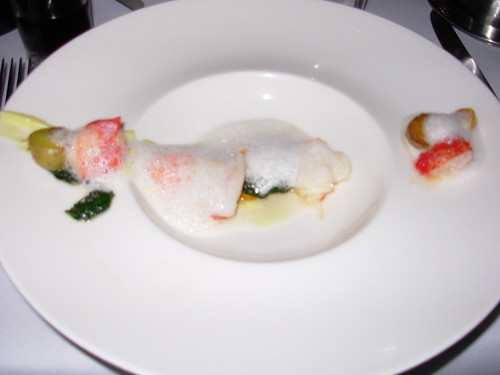
On the printed menu Nantucket Bay Scallops were scheduled to be served with the gooseberries, lavender, and potatoes. Instead we were served scallops with white truffle (again, happily), chanterelles, and Brussel Sprouts. This was a one spoon dish (silverware that owed much to Alinea), but it was a terrifically powerful spoonful. The mushrooms, sprouts, and truffle created a dish that captured the mind of mid-November.
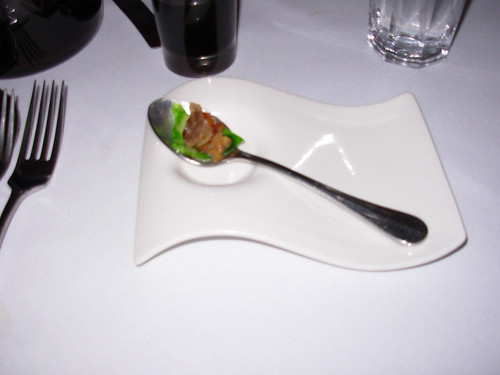
Chef Carlson was surely teasing us with his composition of Sweetbreads, Rhubarb, and Humboldt Fog Cheese. In the middle of a platter was a small pile of thymus, smiling like a goiter. As if emphasizing the embodied origins, a smear of rhubarb red and foggy white flowed from the organ meat. The presentation was characteristic of the Carlson aesthetic, although the dish, tasty in each part, seemed too carefully calibrated, lacking a warm heart.

For the main course, we were served "Beef: Raw, Pickled, and Braised." The trio of servings were petite, and their placement on a spacious plate emphasized their bulk - three bites and on to the next course. The raw was tartare with (I believe) quail egg, served on a plastic "ice cube," accompanied by squibs of sesame oil and yuzu. The yuzu was a surprising match. I have bitten my tongue on many occasions, but never had such a pickled bite. Braised short rib was served with a sweet tomatillo puree, and was delicious, if not shockingly so.
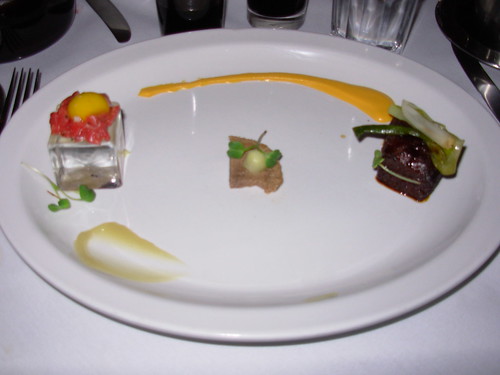
"Cheese" was another heroic single bite. A spoon of al dente risotto, tart apple and Morbier cheese (a semi-soft, ash-filled cow's milk cheese) was suffused with flavors that revealed a gustatory harmony. The apple cut through the creamy and rich rice and cheese. Like other bites, this might have been followed by a train of other bites. Just as the first sip of wine does not perfectly predict one's ultimate pleasure, one-bite tricks produce similar vexation. The first bite alerts the diner what to evaluate, compare, and combine. Dishes need time to breathe and breed.
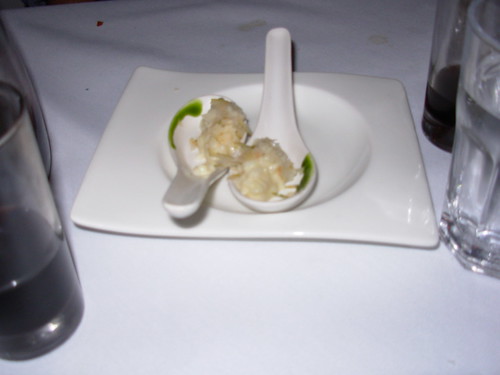
Our two desserts were less compelling that the main courses. I wasn't fond of the olive shortcake with olive oil ice cream and strawberry mousse. It's sweetness had an off-taste. The plate was startlingly pretty, but not divine on the tongue. Chef Carlson's chocolate brownie with pumpkin seeds was a more satisfying construction, but not filled with the possibilities of memory. It was a fine brownie. Were it permitted, I would have selected other confections.
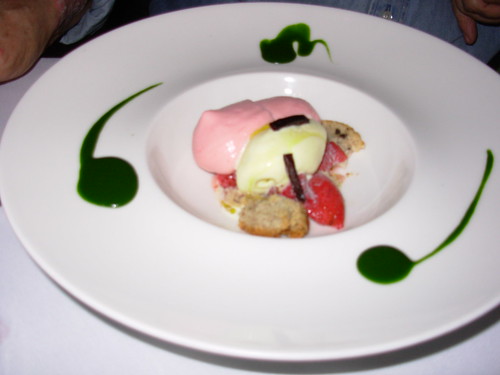
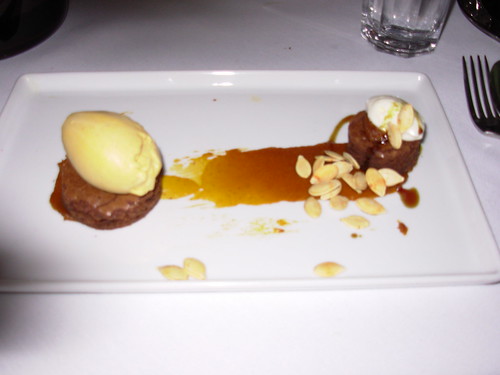
Michael Carlson matters for our culinary future. He is blessed and limited in his locale. How much better he can get in his current location, and should we wish that he has a drive for improvement. Some dishes were a little off and some might have been tweaked or expanded, but the idea that we were eating food this stunningly satisfying in a little storefront on the West Side of Chicago made us brave adventurers with Carlson a bravura guide. I admit - sheepishly - that I award the idea of Schwa a solid four stars with its food at three-stars-plus. But that night I was where the action was - and where the action might not be for long. Does Chef Carlson owe us a sumptuous showplace with a corps of cooks readying an elaborate mise-en-place or does a heady gig more than suffice? I'm not taking chances. My morning-after routine is to schedule a future repast.
Schwa
1466 North Ashland
Chicago (West Town)
773-252-1466
www.schwarestaurant.com
